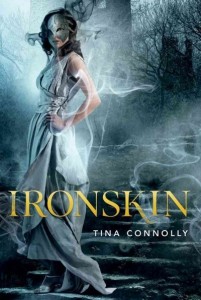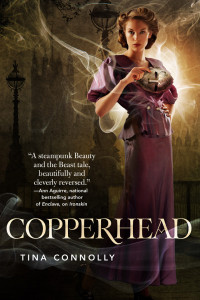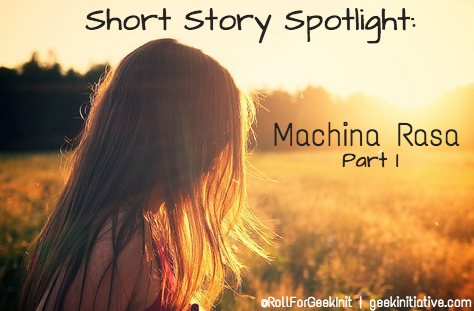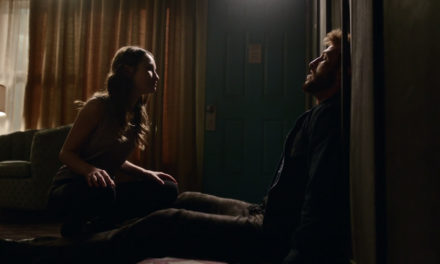When I first read Ironskin, I felt vindicated. Its very existence meant that other people enjoyed reading flowery but pungent language; that others relished in the nostalgic aesthetic too often neglected in contemporary work. Ironskin‘s residence on the bookstore’s shelf also meant that someone was bold enough to write it – and ever since page one, I wanted to know who was behind the words on the page.
I was fortunate enough to interview Tina Connolly, author of Ironskin, Copperhead, and Silverblind (coming this fall). Connolly is also an accomplished podcaster and flash fiction author who regularly attends workshops and conferences. I asked her about her writing technique, influences, and more.
Tara M. Clapper: You have a very descriptive, visceral style focusing on the aesthetic. It’s quite different from other works of fantasy and general fiction. How did you come to develop this style over your years as a writer?
Tina Connolly: It might sound odd, but I tend to think in rhythm when I’m writing. I mean the ebb and flow of a sentence feels important. It might be because I come from an acting background—and still do a lot of podcasting—so I’m always thinking about the way things sound, and the beats of silence.
Language fascinates me, and slang, and the rhythm of conversations. I’m an inveterate reviser. I go back and tinker with the same sentences over and over, until they mean what I want them to say, and they sound right saying it.
I love language so much that my style gets pushed in different ways for different stories. I have a few stories that are thick with made-up slang. (When I use a word, says Humpty Dumpty, it means what I choose it to mean. I like to imagine this is true.) And then the Ironskin series, and Ironskin in particular, were pushed toward the gothic.
TMC: How did you get the inspiration and idea to write Ironskin and to use Jane Eyre as a basis for it?
TC: Ironskin started as a short story. I had an image of a girl going into an artist’s studio at midnight and finding a mask of her own face—but beautiful. From there I started asking who was the artist who would make such a thing, and what would be their complicated relationship. The story had thematic similarities to Jane Eyre, and when I decided that the short story was going to turn into a novel, I consciously expanded on the Jane Eyre similarities and plotline to tell the story. I have always loved Brontë‘s work, and I wanted to work with many of the same themes she was working with, about beauty and feminism.
TMC: Tell me what it was like the first time you actually completed a manuscript and sent it off to an agent or publisher. Were you nervous?
TC: Heh. Yep! I’d been submitting and selling short stories for four years at that point, so you’d think it would have been a breeze, but nope. It felt like a whole new ball game. I had a short list of a couple dozen agents, and I sent out a couple emails at a time. I was really nervous every time I sent out a new email. My agent was one of my top picks, so I was—obviously—pretty darn excited when she requested the partial. She had to pick my email out of her spam filter, too! And then we went on submission to editors and I was nervous all over again, even though I knew full well that publishing takes ages. But it’s hard to be so close to a lifetime goal and not be nervous, I think.
TMC: We’ve read about Jane and Helen – what’s Dorie going to be like now that she’s all grown up?
TC: When I was first working on Ironskin, I kept thinking–boy, I’d love to tell grown-up Dorie’s story some day. It was so satisfying to finally get to work on that story and explore her character. I dropped in some hints at the end of Copperhead about some new capabilities Dorie was just discovering about herself. And now in Silverblind, we get to see her exploring those abilities, when she disguises herself as a boy in order to get hired to do field work—hunting wyvern eggs and going up against basilisks and so on.
TMC: In Ironskin, the relationship between Jane and Dorie is very complex, just as many mother-daughter type relationships are in real life. Did you draw on personal relationships of your own when you thought about how the two interacted?
TC: Thanks. It’s interesting to be asked about the Jane-Dorie relationship–a lot of questions I’ve had have been about the sibling relationship between Jane-Helen. It’s funny–I have a great, strong, family, but I’m really drawn to exploring family dynamics, and the way familial relationships function–or don’t. It’s hard to tease out anything particular from my own life, but I do have three younger siblings—as well as did a lot of babysitting—so some of Jane’s struggles with Dorie did come from me thinking through challenges that small children can put you through.
TMC: Do you see fantasy literature as a field dominated by men? Have you experienced any sexism as you advance in your career?
TC: It’s probably obvious from the Ironskin series that I think a lot about feminist themes, and I’m drawn to telling these sorts of stories where I explore these issues. I was breaking down a new book at the CSSF workshop with Kij Johnson a couple years ago, and I was like, well, it’s about the intersection of beauty and feminism and the use of power . . . oh wait, that’s Ironskin all over again. But it’s what I’m drawn to, right now. I don’t have any flashy examples of overt sexism to share, but I find the sort of general institutionalized sexism out there in the world in general so frustrating that I keep returning to it in my fiction. Especially when I get fed up with the stories I see told over and over on the screen.
TMC: Has being a mother influenced your writing in any way? If so, how?
TC: Hahahaha! Mostly I’d say it’s influenced me learning how to write at the drop of a hat. (And write two sentences here, and two there, and two there . . .) In 2010 I sold two books to Tor, and then a month later I had a baby. So I had to learn how to write on deadline and adjust to a baby at the same time. Last year I sold two more books to Tor (Silverblind, plus an already-written unrelated YA book, Seriously Wicked), and I had to turn Silverblind in before our second baby was born. That was a bit of a race! But we all made it.
However, I do have a short story coming out in the humorous anthology UFO 3, edited by Alex Shvartsman, that very specifically came out of being a mom. It’s told in emails—written from the perspective of an email support group for moms of very young supers.
TMC: How and why did you get into podcasting?
TC: I was a theatre geek for a long time before I switched over to writing. Way back when Rachel Swirsky was running Podcastle, she asked me if I’d like to record a story for her. I jumped at the chance to do some voice acting again. It snowballed, and then in 2012 I decided to start a flash fiction podcast, Toasted Cake. I was just going to do one year of 52 eps, but then Toasted Cake picked up the Parsec for best new podcast, so I decided that was a good sign to keep going! I’ve loved running the podcast–flash fiction is underappreciated (insert soapbox here!), and it’s been such a lovely way to interact with other authors, especially when I’ve been snowed in at home with book deadlines and babies the last couple years.
TMC: I know I’ve learned a lot from role playing a character who wears a mask (in a live action role play setting). What have you discovered as a result of masks being such a central theme in your work? What challenges does it present when you write a masked character?
TC: That’s interesting. I have a friend who does a lot of masked theatre, but I can’t recall being in any shows where I’ve had to regularly wear one. I imagine that would be an interesting character to role play. One technical challenge it represents for sure is that anytime a character has a “prop”—I’m using the term loosely here—you have to remember to think about where the prop is at all times, and what limitations it would be causing. In Silverblind, Dorie ends up with a baby wyvern that she has to take care of–so she, and I, have to think: is the wyvern hungry, is the wyvern sleepy, is the wyvern going to yodel at inopportune times. . . .
TMC: You’ve also published a great deal of short fiction. Do you usually find yourself drawn towards writing these short stories or longer narratives on a daily basis?
TC: When I first started, I wrote only short things–3000 words was about the longest I could make a story. (Editors would say that my stories felt underdeveloped.) Eventually, slowly, I managed to write longer and longer. Even so, the first draft of Ironskin came in at only 60K, which is on the short side for an adult novel! (The final version is around 80K.) It took me a long time to figure out how to write novels, but now that I’ve written ten of them, I really enjoy the form. I ALSO really love flash–love the challenge of working at that length (750 words or so) and love what you can do with a really good piece of flash. So lately, it seems like all I write are novels and flash. I wouldn’t be surprised if this continues for awhile.
TMC: As far as other novelists go, who has inspired you?
TC: A random and unordered list: Diana Wynne Jones, Patricia A. McKillip, Robin McKinley, Anne McCaffrey, Jane Austen, Charlotte and Anne Brontë (obviously), Saki, Noel Streatfeild, Roald Dahl, Kristin Cashore, Edith Wharton, Margaret Atwood, L M Montgomery. Every time I read Diana Wynne Jones’ books, I want to write. Particularly Witch Week, for some reason.
TMC: What is your advice for young and aspiring authors?
TC: I just got back from teaching at the Cascade Writers Workshop here in the Pacific Northwest (where I had a fabulous time, as always.) It’s a great little weekend workshop, with good critiques and loads of advice about writing and the biz. A critique group—in person or online—can be really helpful when you’re beginning. But I think my favorite advice has always been to figure out what you love, and stuff your writing full of that.
You can learn more about Tina Connolly and her works on her website, tinaconnolly.com. Listen to Connolly’s flash fiction podcast at Toasted Cake.








